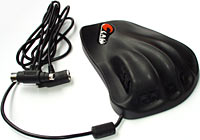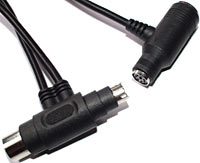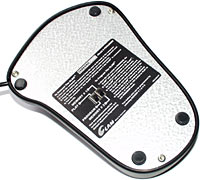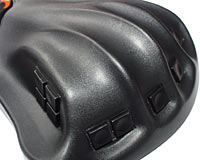
The Claw
Review date: 28 February 2001.Last modified 03-Dec-2011.
If you want to be an awesome ninja cyber-warrior, recipient of the adulation of your action game playing friends and of bitter accusations of cheating from those who just can't come to terms with your transcendent studliness, the keyboard stands in your way.
Oh, you can set up your key combinations so switching from the Botulin Cannon to the Spiked Sink Plunger doesn't require you to do stride-piano-bassline stretches across the keyboard. But it can be hard to come up with a config that doesn't force you to occasionally move your fingers off those important stop-you-getting-killed basic movement keys.
Cue the Claw. Or the CLAW™, to use the PR-man approved name from the official site.
It's a swoopy lump of black plastic, contoured for a left hand, with programmable buttons right under the fingertips. Made here in Australia, and selling locally for a quite reasonable $AU104.50, delivered.
Installation
The Claw uses a simple keyboard connector pass-through cable as its only link to the computer. It's got connections for full-DIN and PS/2 keyboards, and it's transparent to the user. It has no effect on the operation of the keyboard itself.
If you use a USB keyboard but still have an old-style keyboard connector on the computer, you can plug in the Claw, but you can't program it.
Assuming you've got an old-style keyboard, though, plugging the thing in is the entire Claw installation procedure. No drivers, no other software.
Setting up
The basic instructions for programming the Claw are printed on the bottom, around two switches. One switch activates program mode, and the other changes the memory set you're dealing with - you can set up two different key-sets.
You've got two buttons for the index finger, one for each of the three other fingers, and four thumb buttons.
To program a button, you switch to program mode (whereupon the Claw emits a constant annoying tone), press the button on the Claw that you want to program (resulting in a beep-beep-beep noise), and then press whatever keyboard key you want to bind to that button.
The Claw also supports sequences of up to five keystrokes bound to each button. To program a multi-keystroke button, you just assign a key to a button, then press the same button again; the next key you bind will be added to what you bound before.
Since a lot of games - and certainly the FPSes that the Claw's chiefly aimed at - allow advanced user scripting, it's perfectly possible to do complex things with only one keystroke, of course. Anything you can bind to one key on the normal keyboard, you can bind to one Claw button press.
The current Claw also has a somewhat hacked-in modifier button function. When you bind right-Shift to any button on the Claw, that button becomes the modifier key. Now, with the modifier button pressed along with any multi-keystroke button, you get the first keystroke assigned to the button, and nothing else. Without the modifier button pressed, you get everything but the first keystroke.
So if you assign a modifier button and then assign "abc" to another button, pressing that button by itself will give you "bc" and pressing it with the modifier key will give you "a".
Using it
I was doubtful about the ergonomics of a controller on which your fingers pulled on the buttons, rather than pushed down on them, but it's easy enough to get used to the Claw. The four thumb buttons are about as easy to use as they can be, and the finger buttons are simple. It's not even very tricky to press both index finger buttons at once, if your setup requires it.
The buttons have an OK tactile click; they're slightly wobbly, but seem tough enough. The standard nine buttons, without the modifier, may be enough for simpler games. Even if you've only got a two button mouse and assign, say, fire and forward to its two buttons, your average First Person Shooter only needs about eight more immediate control keys - generally something like alt-fire, jump, duck, strafe left, strafe right, move back, reload and walk. Which conveniently leaves one button free to be the modifier.
Weapon selection can be a tad trickier. In games where you really want weapons at your fingertips (for the old whip-out-the-pistol emergency blast in Counter-Strike, for instance) it's generally a pain to use a mouse wheel doohickey for selection. So Claw users will have to use modifier key combinations.
This is easy enough to get the hang of, really, but I don't know if the Claw's really significantly faster for weapon-switching than a keyboard with weapon keys bound to something sensible.
Inside
The steel base plate of the Claw is held on with Torx screws, to keep untutored people out. Since I'm an untutored person with a set of Torx drivers, the funny screws didn't work.
Internal examination revealed that Ferraro Design is doing their bit to support the Australian hot melt glue industry, and that the Claw is, unsurprisingly, built around an off-the-shelf eight bit CMOS microcontroller - a Microchip Technology PIC16CE625, to be exact.
The microcontroller's socketed, so it can be replaced with an upgraded model; there's no way to software-upgrade the Claw, but you could install a new chip for it easily enough.
There are two more soldered-on chips of no particular interest - a Philips 74HC151N eight-input multiplexer and an ON Semiconductor MC14066BCP quad analogue switch/quad multiplexer.
Overall
Are you left handed? Well, wait for a Claw for the right hand, because this one's useless to you. If you have really small hands, it'd be annoying to use, too.
The pass-through connectors are good, because there's a socket of one size and a plug of the other on each pass-through section. Whichever plug you use for your computer, the keyboard plugs into the other pass-through part. That means you don't have the keyboard cable dangling from a plug extension straight out of the socket, and straining the connection.
Unfortunately, though, the PS/2-plug pass-through part has its cable exit so placed that that it'll obstruct the standard USB ports on an ATX motherboard. You can still plug things into the USB ports, but it's awkward. Claws are apparently now coming with a "USB Saver Cable" which solves this problem, according to the installation page here, but the Claw I reviewed didn't have one.
Apart from that, there's not much not to like about the Claw. It installs easily on any PC with a regular external keyboard, it needs no drivers, it's quite easy to program, and you can program it without even quitting a game. You can set it up differently for two different games, it's comfortable, and despite its wild looks it's actually pretty easy to get the hang of.
And at around a hundred bucks Australian, it's not a very expensive upgrade, either.
If you're not a game enthusiast, or if you're perfectly happy with keyboard controls, or if you play games with far too many key commands for the Claw to handle, then this isn't the gadget for you. Given the price, though, it's pretty darn cool. Recommended.






